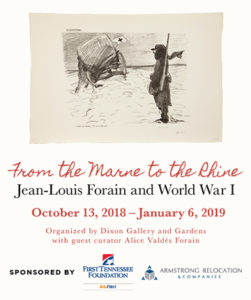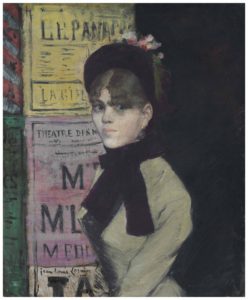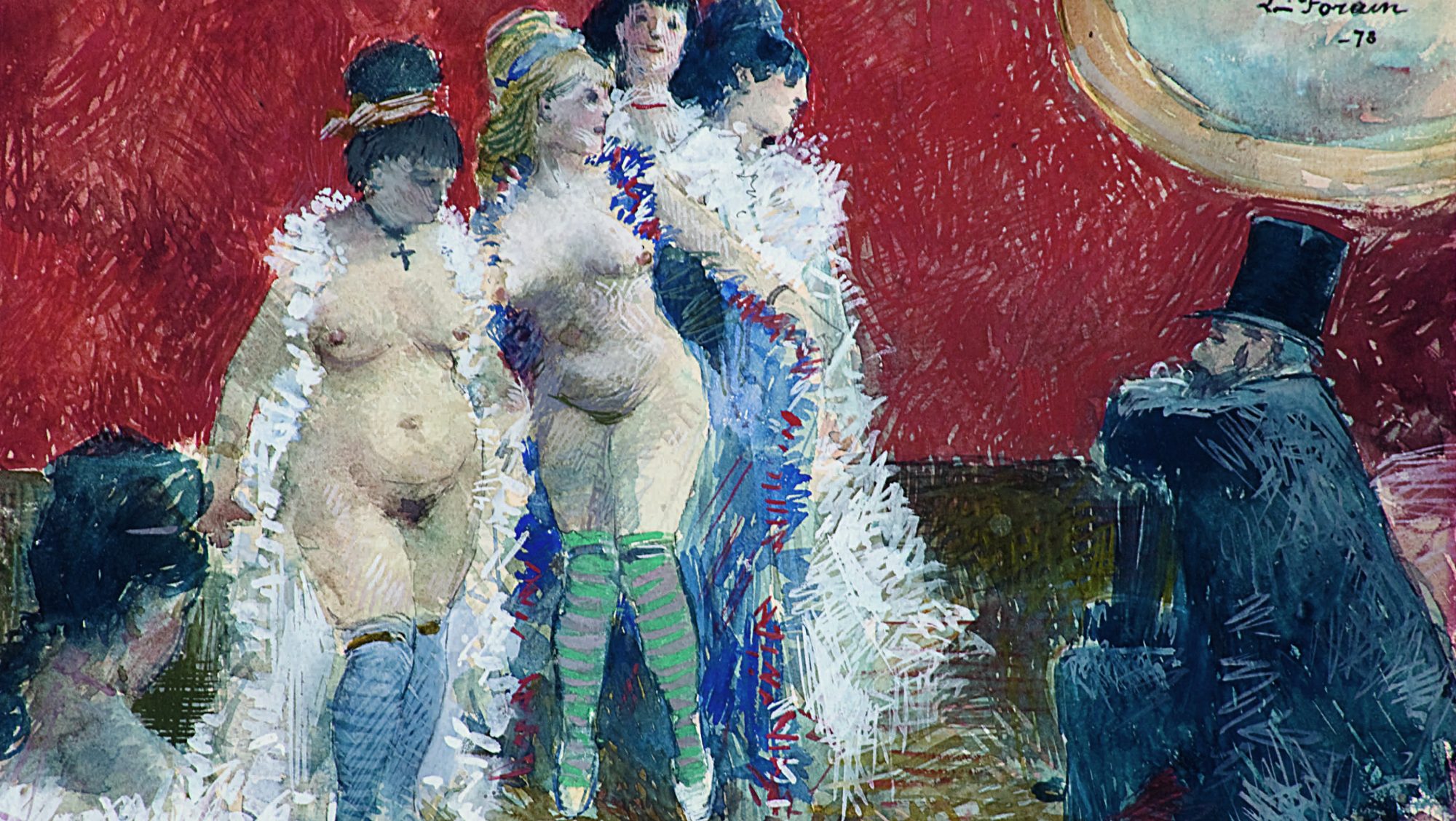Sorry, this entry is only available in French.
(Français) L’art est dans la rue au musée d’Orsay
(Français) Forain à Deauville !
(Français) Forain outre-Manche : « Impressionnistes sur papier : Degas à Toulouse-Lautrec » Royal Academy of Arts
(Français) De Reims à Paris : le brillant parcours de Forain (1852-1931) , peintre et illustrateur de presse
(Français) Derniers jours pour admirer le portrait de Jeanne Forain présenté à l’exposition “Cinq cents ans de dessins de maîtres” à la Fondation Custodia
From Marne to the Rhine: Forain and World War I
Until January 6, 2019 , The Dixon Gallery and Gardens, Memphis, Tennessee, celebrates the 100th anniversary of Armistice Day with a selection of Jean-Louis Forain’s striking press illustrations of the Great War. From the Marne to the Rhine: Forain in World War I, showcasing prints gifted by John and Lynn Murray in honor of William and Mary Murray, delves into the events of a war that changed the world.
At the turn of the century, Jean-Louis Forain (1852-1931) was already a celebrated painter and satirical draughtsman renowned for his sharp insight into contemporary Parisian habits. As a press illustrator, Forain closely followed the evolution of the international political scene and the rising tensions between France and Germany. With more than 200 war cartoons published in weekly and daily newspapers, Forain became the spokesman for the common soldier on the western Front, the main theatre of war approximately located between the Marne and the Rhine rivers. His description of war realities depicted the great battles and life in the trenches. This brought conciseness and irony to bear on political, military, economic and social issues with many of his drawings directly relating to the army fighting in Europe and the engagement of the United States in the conflict.
“You have to let the paper breathe”, Forain once affirmed. He emphasized one element or another by sketching against an uncluttered background in order to make his message very clear. Confident in his talent for capturing movement and volume, his line became increasingly simple. His vigour and swiftness of execution, the depth of his blacks and the luminosity of his whites made him the most famous caricaturist of his time. Forain did not deform or distort figures or facial expressions to make his characters grotesque as he quickly perceived that one does not win a war solely on the battlefields. France was facing an enemy not ready to be defeated, therefore, the draughtsman committed to maintaining the spirit and patriotism of his contemporaries. Showing the drama underneath the comedy, the drawings give with emotion, irony, pity, sorrow, indignation and compassion, a priceless testimony of how military and political events affect populations. From the Marne to the Rhine: Forain in World War I encapsulates the artist’s unique style and incredible science of composition, which undoubtedly contributed to the evolution of the art of the editorial cartoon.

Organised by The Dixon Gallery and Gardens with guest curator Alice Valdes-Forain.
October 13, 2018 – January 6, 2019
(Français) En correctionnelle de Jean-Louis forain devient un tableau sculpté en 3D
A standout painting by Jean-Louis Forain, “La femme aux affiches” from the Collection of Peggy and David Rockefeller about to be sold at the sale of the century at Christie’s New York

Few months ago, the auctioneer Christie’s brought us for examination this magnificent representation of a Parisian behind vibrantly coloured posters. Painted by Jean-Louis Forain in the 1880s, it offers a perfect overview of the habits of the artist, the great chronicler of Parisian life at the Belle Epoque. Check out what Christie’s has to say on this standout painting!
A.Valdès-Forain
.
.
.
Forain’s La femme aux affiches offers a brief glimpse into the artist’s personal experiences of travelling through the bustling streets of Paris during the early years of the Belle Époque, as flashes of modernity began to dramatically alter the very fabric of the city and its identity. A regular contributor to the contemporary journals and news outlets of his day, Forain earned a reputation throughout Paris as an insightful and satirical illustrator, unafraid to take aim at the prevailing social codes and habits of the city’s well-to-do inhabitants. Demonstrating an acute ability for capturing the subtle nuances of class and etiquette that colored even the most prosaic of interactions, Forain became an astute chronicler of the gradually shifting social and power structures of the period, as traditional boundaries between the classes began to disappear. A keen observer of life, Forain slipped easily into the role of the typical flâneur, absorbing the city’s sights and sounds, experiencing its play of life first-hand, using the numerous scenes of la vie Parisienne that he encountered while strolling along the capital’s boulevards as the primary inspiration for his compositions.
In La femme aux affiches, Forain immortalizes one of these fleeting encounters, painting a portrait of one of the fashionable young women who populated the city’s boulevards as they went about their daily business. This anonymous lady, elegantly dressed in a rich plum-colored hat adorned with flowers and ribbons, stares straight out at the viewer, her large, almond shaped eyes drawing us in to her world and holding our gaze, despite the bright colors and bold graphics of the posters which adorn the newsstand behind her. Capturing the varying textures and details of her costume with the briefest of brushstrokes, from the play of light on the sleeve of her dress to the intricate design of her earring, Forain illustrates the importance of fashion and appearance in the lives of these young women, while also perhaps casting a critical eye on the changing role of clothing as a means of identifying social status during this period. Indeed, there is a certain ambiguity as to his subject’s identity—this young woman might be a well-to-do middle-class figure out for a day’s shopping, or perhaps an aspiring actress or ballet dancer on her way to an audition, or even an enterprising sales assistant from one of the city’s glamorous department stores. As such, she remains a figure of mystery, an enigmatic, elegant woman who briefly captured Forain’s attention, and through the power of her gaze, left an indelible impression on the artist’s memory.
The Collection of Peggy and David Rockefeller: Fine Art, Day Sale
New York, Rockefeller Center, 10 May 2018
Jean-Louis Forain (1852-1931)
La femme aux affiches
signed ‘jean louis forain’ (lower left)
oil on canvas
22 x 18 3/8 in. (55.9 x 46 cm.)
Painted circa 1880-1885
Provenance
Galerie Paul Rosenberg, Paris (by 1917).
Kirster Littorin, Stockholm; sale, Bukowskis, Stockholm, 7 September 1932, lot 107.
Lieutenant-Colonel Rosander, Stockholm (acquired at the above sale).
Ernst A. Kruger, New York.
M. Knoedler & Co., Inc., New York (acquired from the above, 1937).
Abby Aldrich Rockefeller and John D. Rockefeller, Jr., New York (acquired from the above, July 1937).
Laurance Spelman Rockefeller, New York (gift from the above, June 1947).
Acquired from the estate of the above by the late owner, February 2005.
